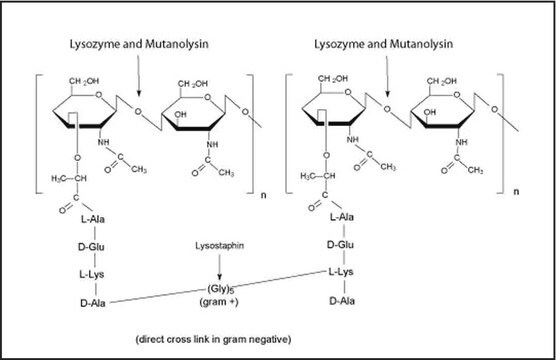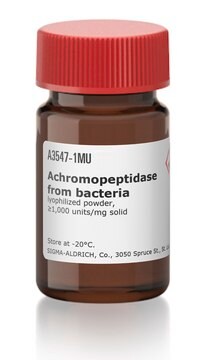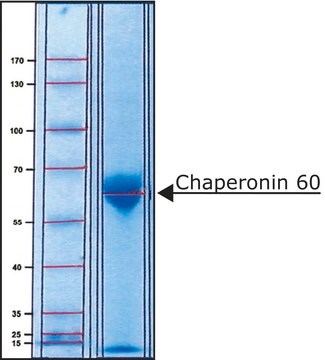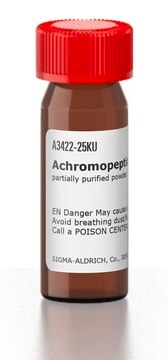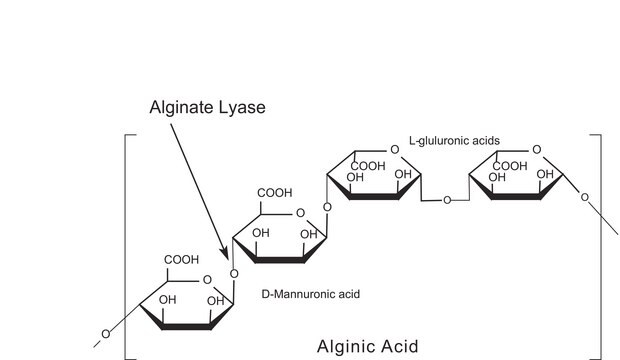L9043
Lysostaphin from Staphylococcus simulans
recombinant, expressed in E. coli, lyophilized powder
Synonym(s):
Glycyl-glycine Endopeptidase
Sign Into View Organizational & Contract Pricing
All Photos(1)
About This Item
CAS Number:
MDL number:
UNSPSC Code:
12352204
NACRES:
NA.54
Recommended Products
biological source
bacterial
Quality Level
recombinant
expressed in E. coli
Assay
≥90% (HPLC)
form
lyophilized powder
specific activity
≥3000 unit/mg solid
technique(s)
molecular cloning: suitable
suitability
suitable for sequence analysis test
application(s)
life science and biopharma
shipped in
dry ice
storage temp.
−20°C
Looking for similar products? Visit Product Comparison Guide
General description
Lysostaphin, a zinc metalloenzyme, is mainly secreted as a proenzyme. It acts as an anti-staphylococcal agent and is highly stable at pH 4 and 5°C.
Application
Lysostaphin from Staphylococcus simulans has been used in a study to assess molecular cloning, sequencing, and expression of lytM, a unique autolytic gene of Staphylococcus aureus. It has also been used in a study to investigate the sequence analysis of a Staphylococcus aureus gene encoding a peptidoglycan hydrolase activity.
Biochem/physiol Actions
A protein complex with highly specific lytic activity against Staphylococcus species, including Staphylococcus aureus.
Lysostaphin possesses a lytic action against Staphylococcus aureus, which is used to treat antibiotic-resistant staphylococcal infections. It has the properties of enzymes, such as glycylglycine endopeptidase, endo-β-N-acetyl glucosamidase and N-acetyl muramyl-L-alanine amidase. Lysostaphin is also used as a preservative in food industry and in clinical labs for rapid screening.
The antimicrobial activity of lysostaphin, a metalloendopeptidase expressed by Staphylococcus simulans, is enhanced by binding to the C′ terminus of the membrane-associated Trap protein of Staphylococcus aureus.
Signal Word
Danger
Hazard Statements
Precautionary Statements
Hazard Classifications
Resp. Sens. 1
Storage Class Code
11 - Combustible Solids
WGK
WGK 3
Flash Point(F)
Not applicable
Flash Point(C)
Not applicable
Personal Protective Equipment
dust mask type N95 (US), Eyeshields, Gloves
Choose from one of the most recent versions:
Already Own This Product?
Find documentation for the products that you have recently purchased in the Document Library.
Customers Also Viewed
C-terminus of TRAP in Staphylococcus can enhance the activity of lysozyme and lysostaphin.
Yang, G.
Acta Biochimica et Biophysica Hungarica, 40, 452-458 (2008)
L Ramadurai et al.
Journal of bacteriology, 179(11), 3625-3631 (1997-06-01)
A gene encoding an autolytic activity was identified in an autolysis-deficient mutant (Lyt-) of Staphylococcus aureus which produces only a single band in autolytic-activity gels (N. Mani, P. Tobin, and R. K. Jayaswal, J. Bacteriol. 175:1493-1499, 1993). An open reading
X Wang et al.
Gene, 102(1), 105-109 (1991-06-15)
The nucleotide (nt) sequence of a 2.0-kb NheI-XbaI DNA fragment containing a peptidoglycan hydrolase-encoding gene, lytA, tentatively identified as encoding an N-acetylmuramyl-L-alanine amidase, from Staphylococcus aureus, was determined. The nt sequencing revealed an open reading frame (ORF) of 1443 bp
Lysostaphin: an antistaphylococcal agent
Kumar J K
Applied Microbiology and Biotechnology, 80(4), 555-561 (2008)
Grégory Francius et al.
Journal of bacteriology, 190(24), 7904-7909 (2008-10-07)
The advent of Staphylococcus aureus strains that are resistant to virtually all antibiotics has increased the need for new antistaphylococcal agents. An example of such a potential therapeutic is lysostaphin, an enzyme that specifically cleaves the S. aureus peptidoglycan, thereby
Our team of scientists has experience in all areas of research including Life Science, Material Science, Chemical Synthesis, Chromatography, Analytical and many others.
Contact Technical Service


